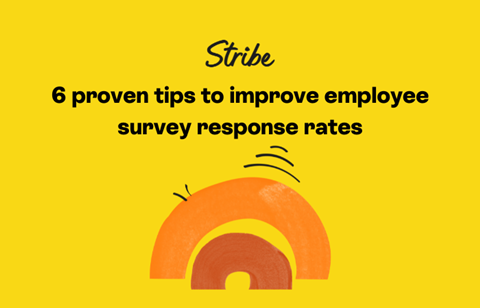
Employee surveys are the gateway to understanding your team’s feelings, needs, concerns, and big ideas.
In this article, we’ll reveal six proven tips to not only boost response rates but also dive deeper into why they matter so much. After all, higher response rates mean richer data and a clearer understanding of what makes your team tick.
1. Keep it simple and convenient
When employees find it convenient and effortless to participate, they are more likely to engage with your survey.
Imagine receiving a survey that’s a lengthy, complex labyrinth of questions, requiring an extensive time commitment. Now, picture another survey that’s concise, straightforward, and can be completed in a matter of minutes.
Which one would you be more inclined to complete promptly? The latter, undoubtedly.
For instance, instead of a 20-minute questionnaire, consider a brief 5-minute pulse survey check on specific topics, like workplace satisfaction or project feedback. Keep it user-friendly, and you’ll see a welcome surge in response rates.
2. Get the timing right
Avoid catching your employees during their busiest workdays or during stressful project deadlines. Instead, choose a time when they can dedicate their attention to providing thoughtful responses.
According to Stribe data, the optimal times to send a pulse survey for best response rates are:
- Mondays between 10am – 11am
- Thursdays between 10am – 11am
- Fridays between 2pm – 3pm
3. Anonymity assurance
When employees feel their responses are confidential, they’re more likely to share authentic opinions, concerns, and suggestions.
By clearly communicating the survey’s anonymity, you create a safe space for candid feedback, which not only improves response rates but also ensures the feedback received is authentic and valuable.
This leads to a more accurate representation of their thoughts and experiences, making the survey results more meaningful and actionable for your organisation.
4. Remind, and remind again!
Sending timely reminders can be a gamechanger when it comes to improving response rates for your employee survey.
Research has shown that repeating messages increases the likelihood of desired actions. In fact, a study by the Society for Human Resource Management (SHRM) found that response rates for surveys can increase by up to 50% with the use of strategically timed reminders.
These gentle nudges ensure that your survey doesn’t get lost in the hustle and bustle of the workday, and you’ll keep the survey top-of-mind for your employees.
5. Manager buy-in
Securing support from managers is a strategic move that can significantly impact your employee survey response rates.
When managers champion your survey and actively participate themselves, it sets a powerful example for their teams. Leading by example demonstrates a commitment to transparency and open communication, encouraging employees to follow suit.
When employees see their managers taking the survey seriously, they’re more likely to perceive it as an important company initiative rather than a mere formality. This buy-in not only boosts participation rates but also reinforces a culture of engagement, active participation, and feedback within the organisation.
6. Commit to action
Arguably the most crucial tip in our arsenal for boosting employee survey response rates is the commitment to transparently share both the survey results and the actionable steps your organisation plans to take.
This step is where the magic happens.
When employees see that their feedback isn’t disappearing into a void but is being heard, acknowledged, and acted upon, they become more invested in the survey process. It’s a tangible demonstration that their voices matter and that the organisation is dedicated to making positive changes based on their input.
This sense of involvement and impact not only motivates higher participation rates in current and future surveys but also nurtures a culture of trust, engagement, and continuous improvement.
When people are heard, teams are happy!
Stribe makes it easier for business leaders and HR teams to support the engagement and wellbeing of their employees. Learn more about Stribe and how our employee engagement platform can help your team be the best they can be.












